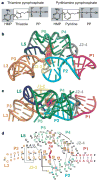Structural basis for gene regulation by a thiamine pyrophosphate-sensing riboswitch
- PMID: 16728979
- PMCID: PMC4689313
- DOI: 10.1038/nature04740
Structural basis for gene regulation by a thiamine pyrophosphate-sensing riboswitch
Abstract
Riboswitches are metabolite-sensing RNAs, typically located in the non-coding portions of messenger RNAs, that control the synthesis of metabolite-related proteins. Here we describe a 2.05 angstroms crystal structure of a riboswitch domain from the Escherichia coli thiM mRNA that responds to the coenzyme thiamine pyrophosphate (TPP). TPP is an active form of vitamin B1, an essential participant in many protein-catalysed reactions. Organisms from all three domains of life, including bacteria, plants and fungi, use TPP-sensing riboswitches to control genes responsible for importing or synthesizing thiamine and its phosphorylated derivatives, making this riboswitch class the most widely distributed member of the metabolite-sensing RNA regulatory system. The structure reveals a complex folded RNA in which one subdomain forms an intercalation pocket for the 4-amino-5-hydroxymethyl-2-methylpyrimidine moiety of TPP, whereas another subdomain forms a wider pocket that uses bivalent metal ions and water molecules to make bridging contacts to the pyrophosphate moiety of the ligand. The two pockets are positioned to function as a molecular measuring device that recognizes TPP in an extended conformation. The central thiazole moiety is not recognized by the RNA, which explains why the antimicrobial compound pyrithiamine pyrophosphate targets this riboswitch and downregulates the expression of thiamine metabolic genes. Both the natural ligand and its drug-like analogue stabilize secondary and tertiary structure elements that are harnessed by the riboswitch to modulate the synthesis of the proteins coded by the mRNA. In addition, this structure provides insight into how folded RNAs can form precision binding pockets that rival those formed by protein genetic factors.
Conflict of interest statement
The authors declare no competing financial interests.
Figures




Comment in
-
Structural biology: RNA switches function.Nature. 2006 Jun 29;441(7097):1054-5. doi: 10.1038/4411054a. Nature. 2006. PMID: 16810234 No abstract available.
References
-
- Mandal M, Breaker RR. Gene regulation by riboswitches. Nature Rev Mol Cell Biol. 2004;5:451–463. - PubMed
-
- Nudler E, Mironov AS. The riboswitch control of bacterial metabolism. Trends Biochem Sci. 2004;29:11–17. - PubMed
-
- Soukup GA, Soukup JK. Riboswitches exert genetic control through metabolite-induced conformational change. Curr Opin Struct Biol. 2004;14:344–349. - PubMed
-
- Winkler W, Nahvi A, Breaker RR. Thiamine derivatives bind messenger RNAs directly to regulate bacterial gene expression. Nature. 2002;419:952–956. - PubMed
-
- Schowen RL. In: Comprehensive Biological Catalysis. Sinnott M, editor. Vol. 2. Academic; San Diego: 1998. pp. 217–266.
Publication types
MeSH terms
Substances
Associated data
- Actions
Grants and funding
LinkOut - more resources
Full Text Sources
Other Literature Sources
Molecular Biology Databases

